Ron Clements and John Musker knew immediately what they wanted to do after The Little Mermaid. Pirates! In! Space! They had, after all, been pitching it to Disney for years by this point, and the success of The Little Mermaid would, surely, let them pursue their dream.
Alas, then chairman of Walt Disney Pictures Jeffrey Katzenberg was not a pirate sort of guy. He did, however, console the successful writer/directors with a tempting offer: they could choose to work on any of the three projects then in development: a little movie about a lion, an adaptation of Swan Lake, and this, well, little thing about Aladdin that lyricist Howard Ashman had been playing with when not obsessed with mermaids, roses, and beasts. Crushed, but impressed by Ashman’s songs, and liking the potential humor of the piece, Clements and Musker agreed to come on board for Aladdin.
Tragically, by the time they came on board, Howard Ashman was in the final stages of AIDS, and unable to collaborate much on Aladdin. Still, he had written a few songs for the film, and with those, Clements and Musker cobbled together a script and storyboards, bringing it to Katzenberg about a month after Ashman’s death.
Katzenberg was not impressed, and demanded a complete overhaul. Clements and Musker brought in two new screenwriters, and took another stab at the story, making multiple changes. In the original version, for instance, as in the original fairy tale, the Genie was able to grant unlimited wishes. In the new version, the Genie could only grant three wishes per person—and those wishes came with some restrictions. That had the decided benefit of forcing Aladdin to use his wits, instead of the Genie, to defeat Jafar (and eliminate the pesky question of “Why didn’t Aladdin just grab the lamp and tell the Genie to bury Jafar in a cage?”). It also made Aladdin’s last wish, to free the Genie, more meaningful—since this also meant giving up his only possible remaining wish, and thus his chance to once again be a prince. Alas, it also meant dropping one of Howard Ashman’s original songs.
Katzenberg also ordered Clements and Musker to eliminate Aladdin’s mother—an important character in the original story and the first draft and storyboards. This meant eliminating yet another Howard Ashman song. (Since Ashman was particularly proud of this one, it can be heard on some DVD releases.)

With two major songs dropped, the music was in chaos. The directors brought in Tim Rice, then well known for his work with Andrew Lloyd Webber on Jesus Christ Superstar and Evita. He was to later work with Disney on The Lion King. From Disney’s point of view, this was a wild success with at least one song, “A Whole New World,” which, combined with Alan Menken’s score (and, for the single, the voices of Peabo Bryson and Regina Bell) became a number one song in the U.S. The song also snagged an Academy Award and a Grammy Award.
From my point of view, this was a little less of a success, since I cannot make myself believe that people can fly to Egypt then China and back in the space of a few hours, magic carpet or no magic carpet, though the nod to China (the original setting of the story) is nice. But that’s probably an unfair criticism of the actual song, which continued to be a Disney staple years after this original release.
Rice’s other major contribution, “One Jump Ahead,” was less successful, and much less memorable. It’s meant, I think, to be similar to Belle’s introductory song in Beauty and the Beast, but something that doesn’t quite work as well—perhaps because it centers on Aladdin and Abu running around stealing things, instead of Belle’s desire to try to find a place where she belongs. Perhaps as a result, within the film, both Tim Rice songs tend to overshadowed by the Howard Ashman written “Friend Like Me,” focusing on the Genie, and the rollicking song “Prince Ali,” which, ok, technically is about Aladdin, but really is a chance for the Genie to show off and happily comment on the parade he’s created.
Or, given the popularity of “A Whole New World,” the real problem may not have been with the songwriters, but simply that in general, Aladdin just isn’t all that good until the Genie arrives, even with stunning animated sequences that were technologically far superior to anything Disney had created before, including a sequence with, for the first time in Disney history, animated backgrounds. Disney had come close to this in The Rescuers Down Under and Beauty and the Beast, and had already developed the computer assisted camera work allowing the camera to swoop and zoom, something that would be perfected in the opening sequence of their next film, The Lion King, but the animated backgrounds for two of the Cave of Wonders sequences were something new indeed.
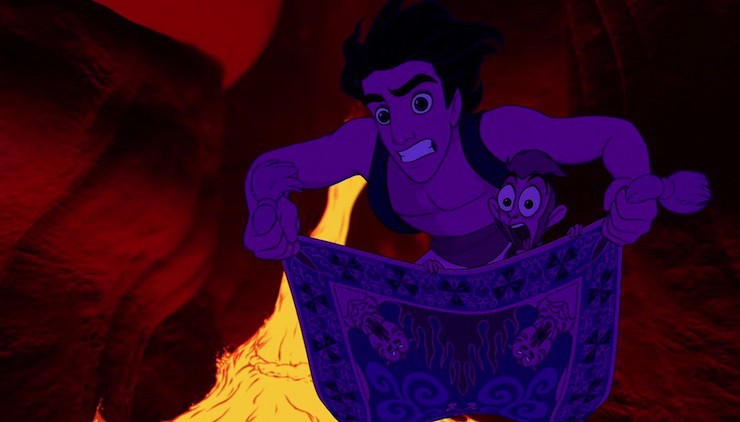
As was Aladdin’s high speed magic carpet ride through the collapsing Cave of Wonders—a dizzying (and I mean that in more than one sense) combination of hand drawn and computer animation, made possible by Disney’s CAPS (Computer Animation Production System) technology. And speaking of CAPS technology and what it allowed: a later sequence set in Jasmine’s bedroom, also created partly through CAPS, finally accomplished something Disney had wanted to do since Fantasia: allow us to see a room through shimmering, moving, gauze curtains—before moving the camera through the curtains to give us a clear look. In terms of beauty and art, Aladdin probably still lingers behind Beauty and the Beast; (though to be fair, Aladdin was also cobbled together much faster after the rewrites); in terms of technology, Aladdin managed to leave even its impressive predecessor far behind.
Perhaps even more impressively, these technological improvements managed to overcome a rather large logistical snarl: Disney executives once again insisting that animation for Aladdin proceed in two locations: the main California studio, and the smaller, newer Florida studio in what was then the Disney-MGM Studios Theme Park (now the Hollywood Studios Theme Park), as part of a tourist attraction. For Beauty and the Beast, different scenes had been assigned to the California and Florida studios, resulting in Belle not always looking like, well, Belle, which was a problem both for viewers and for future toy sales, which needed a single look. This time, Clements and Musker assigned different characters to the California and Florida studios – Aladdin, for instance, was animated in California, and Jasmine in Florida. That still created some logistical headaches, but with extensive use of fax machines, next-day delivery services, and the CAPS system, animators were far more successful in maintaining the same look for all characters throughout the film.
But despite these technological achievements, Aladdin only roars to life once the Genie comes on board—partly because, once he arrives, the stakes become much higher, and because once he arrives, Aladdin’s wistful hope to be something more than a street rat, and Jasmine’s angrier wish to see something more beyond the palace that entraps her and avoid an unwanted marriage, both become possible.
And mostly because with the Genie, Disney animators managed something awesome: animating a Robin Williams improv routine.
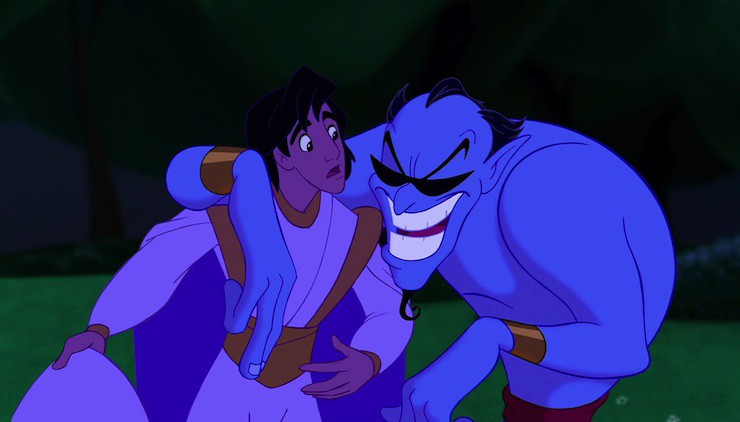
Williams was nearly always at his best when allowed to ad lib, rather than forced to stick with a script. Recognizing this, Disney simply handed Williams the lyrics for the songs and some general guidelines, and let Williams ad-lib everything else. Williams, after reading the guidelines, decided that what was really needed was celebrity impressions, eventually creating around 54 of them. though not all of the impressions made it into the final film.
It was brilliant, and dazzling. That said, as much as I love the Jack Nicholson and Groucho Marx impressions (in a great touch, the Genie turns black and white during the Groucho Marx bit), and as much as it pains me to admit it, I fear that this is also one part of a film that is already aging, with fewer viewers able to recognize, say, William Buckley or Arsenio Hall. On the other hand, some of the impressions—like the Peter Lorre bit, or, for that matter, the Arsenio Hall bit—work even without knowing the originals. And the final results create a multilayered creature constantly in shift, constantly borrowing from others. It also gives another layer to Aladdin’s decision to lie to Jasmine: it’s not just that Aladdin believes that Jasmine won’t want to be a street rat (and legally, won’t be able to be with him since she has to marry a prince), but the main person urging him to tell her the truth is someone who keeps shifting into multiple personas, rarely allowing himself to be himself.
It helps, too, that animators added some improvisation and in jokes of their own to the Genie—including references to Pinocchio, The Little Mermaid (poor Sebastian makes a quick, startled appearance), Beauty and the Beast, and Walt Disney World tourists, and in particular, WDW tourists wearing Goofy hats, looking rather like a certain comedian who occasionally visited WDW.
Animators did much less with Gilbert Gottfried’s Iago the parrot, but had quite a lot of fun with Abu, Aladdin’s pet monkey turned elephant, and the voiceless magic carpet, who after an initial bit of shyness, turns into a heroic magic carpet that is also eager to have Aladdin tell the truth—that he’s nothing more than a street rat with a fabulous lamp. They also, more tentatively, decided to try to animate a tiger again. Unfortunately, although computer assisted animation had managed wonders for backgrounds, camera movements, and creating the illusion of a camera speeding through paintings, it had not yet reached the point where it could make animating stripes easy or cheap. As a result, the tiger was eliminated from several scenes, and made to sit very quietly, only moving his head, in others. Animators over on The Lion King hastily reduced the number of zebras.
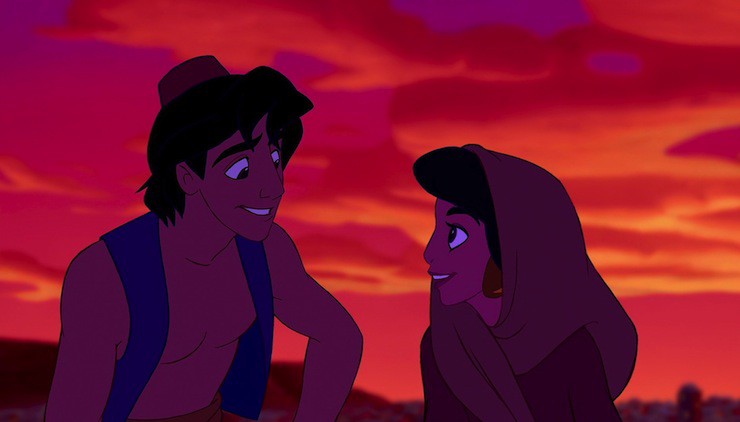
Compared to these side characters, main characters Aladdin and Jasmine feel a bit, well, bland. That characterization is perhaps unfair to both. Jasmine follows in the footsteps of Ariel and Belle as someone unhappy with the restrictions of her world and her lack of choices: like both of them, she takes active steps to change this, and it’s not entirely her fault that she’s a secondary character in a film not all that interested in her, to the point where she was even drawn in what was then the secondary animation studio, Florida. She’s perceptive, and fast thinking, but this isn’t her movie, and in the end, although she does get to choose her own husband, she doesn’t really get a chance, like Ariel and Belle, to move out of her world. She can be shown the world, but she stays in her palace.
Jasmine’s story does have a hint of another, more interesting story, that never does get explored thanks to the decision to turn Aladdin into high comedy: that is, the idea that enclosing yourself behind walls can make you more vulnerable, not less. Because Jasmine has never left the palace walls, she knows nothing about things like money, which almost immediately gets her into trouble. Her father, who has apparently also never left the palace, is easily tricked by Jafar. It takes someone born outside the walls to save them both.
That someone, of course, is otherwise bland protagonist Aladdin, who stands out among Disney protagonists only because he’s one of the few protagonists to start off with somewhat questionable morals. But as Aladdin shows, its protagonist is only one of many poor people living in the shadows of the palace, pretty much all of whom, like the villain Jafar, have slightly darker skin than the palace inhabitants. The original story blamed Aladdin’s poverty on inherent laziness. In the film, Aladdin makes a fairly convincing argument that he’s been forced into a life of petty larceny: he has no other skills, and no one seems interested in hiring him. The film doesn’t exactly agree with this – we never see Aladdin applying for a job, for instance, and throughout the film, Aladdin takes the easy way out whenever possible — but the presence of other pathetic children with huge eyes grateful to eat garbage suggests that Aladdin’s excuse may not be completely off the mark. And of course, the skills he gains through his life of poverty, outside the protection of the palace walls, allows him to save Jasmine and her father, even if he’s not quite clever enough to keep his magical lamp on him at all times.
And of course, Jafar uses that lamp, that poverty, and those lies to take over the kingdom. It’s a sorta mixed message, is what I’m saying.
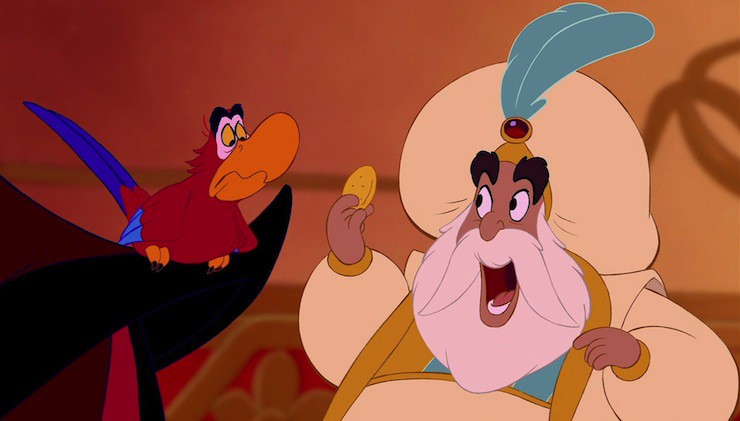
I have other quibbles. For instance, I realize in that Iago the Parrot is not the nicest sort of parrot, but I am still not certain that he actually deserves the evil fate of getting trapped for all eternity in a small lamp with Jafar, especially since Jafar, not Iago, is the one getting the ULTIMATE COSMIC POWERS and Iago just gets the itty leetle living space. And I definitely don’t think that Iago did anything terrible enough to justify forcing him to come back for the sequel, The Return of Jafar, but then again, that’s true for pretty much all of the characters.
Also, a question: given that Aladdin only had three wishes, and two of them had already been used up, would poor Abu have remained an elephant if Jafar hadn’t transformed him back to a monkey? (After all, Aladdin really only had two choices with that third wish—turn into a prince, or free the Genie—neither one of which would have been terribly helpful to Abu. If Abu had been forced to stay an elephant, would he ever have been able to eat a banana again? And what happened to all of the other transformed creatures that entered the city with Aladdin? A deleted scene suggests that all of them were originally cockroaches, rats and other vermin, so they might have been able to blend in quite easily with the rest of humanity. I hope so, since we never see Jafar or the Genie restore their original forms.
Others, most notably the American-Arab Anti-Discrimination Committee, had more serious objections, both to the portrayals of many of the minor characters in the film, and to the lyrics in the opening song. In response, Disney altered the lyrics in the first song from “Where they cut off your ear if they don’t like your face,” to “Where it’s flat and immense and the heat is intense,” but did not alter the portrayals of the other characters until the creation of the Disney Princess franchise, when Disney began creating more costumes for the Jasmine Princess doll.
Disney also ran into trouble with Robin Williams, who had agreed to do the film at far below his usual rates—as long as Disney did not use his name while marketing and promoting the film. Disney did use his name, leading to a feud that ended only when Joe Roth, who had replaced Jeffrey Katzenberg as the Chairman of Walt Disney Studios, publicly apologized.
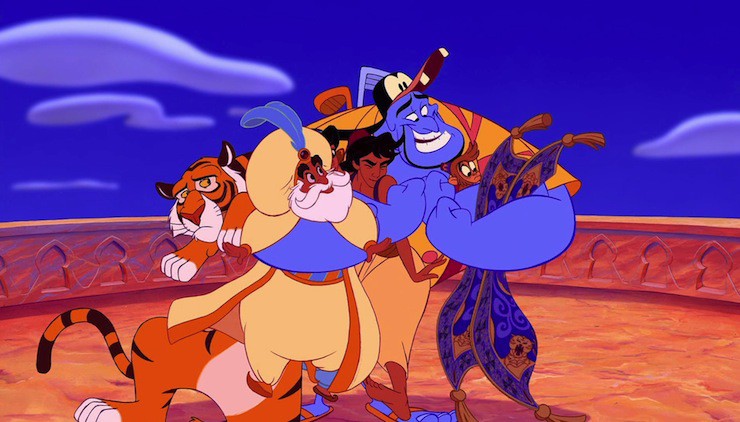
Despite these issues, Aladdin was a major box office success, outgrossing every other film released in 1992, and earning more than any other animated feature up until that time (a record defeated by The Lion King in the following year.) Disney released two generally terrible direct to video sequels, as well as an animated series called Aladdin, where, I’m happy to tell you, Iago the parrot is no longer trapped in the lamp, but also where, I’m sorry to tell you, he’s reformed and a lot less fun. Aladdin also spawned the “Magic Carpets of Aladdin” ride at Walt Disney World and Disneyland Paris, several video games, and a Broadway musical. Jasmine became one of the original Disney Princesses, and continues to make regular appearances at Disney Princess events.
Next up, against my better judgment, The Lion King.
Mari Ness lives in central Florida.










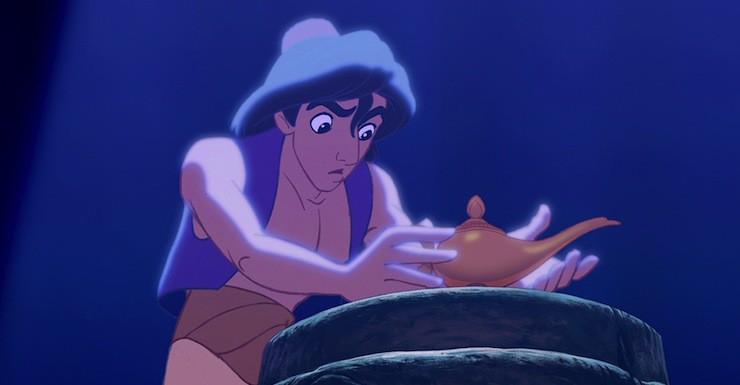
Well, since changing Apu to an elephant was done totally at the Genie’s discretion to sell Aladdin’s “I am a Prince” story, I don’t see why the impetus is on Aladdin to fix it.
But there is still the Plot Hole You Can Drive A Truck Through That Has Driven Me Crazy For Decades, that hugely undercuts any characterization of Jasmine as perceptive and fast thinking (though those things are otherwise true). The one thing her life in the palace HAS prepared her for is palace intrigue, and she’s clearly seething in silence at Jafar without absolutely clear-cut evidence of any wrongdoing on his part. So WHY OH WHY except that’s she’s so dumb that she can’t think straight under the influence of love doesn’t she follow Aladdin’s sort-of admission that he is the same person whom she met in the marketplace (and therefore the same person about whose supposed summary beheading she’s been traumatized only a few days ago) with the question, “Why are you alive??????” And then a mutual race back to the palace to save the Sultan from Jafar’s suddenly revealed perfidy? Argh. I remember a mention of pencils through eyes?
On that topic, everyone’s been trying to guess the pencils-through-eyes reference, and maybe it is still Tangled since there seems to be an issue brewing there in the comments. . .but is our beloved Mari perhaps bracing for the vicious firestorm of decades-old plagiarism allegations that will inevitably ensue with The Lion King?
I think I’ll be somewhere else next week.
I’m loving this guessing game!
To clarify slightly, I find the film in question physically painful to watch. I don’t have the same OW NAILS ARE GOING THROUGH MY EYEBALLS feelings when reading Tor.com comments. Usually :) I am prepared for a small comment storm on The Lion King post, but mostly because that’s a fairly popular film that I think most Tor.com readers have seen or heard of, unlike quite a lot of the source material stuff.
This movie was my very first movie-theater experience. I remember talking for days about the ‘made you look!’ trick at the end.
I think the Return of Jafar was made for the sole purpose of having a guy named Abysmal.
The thing that always annoyed me about this film is that Aladdin doesn’t wish for the Genie to turn him into an insanely rich con artist, he wishes for him to turn him into a prince. Which means that Aladdin is a prince for most of the film. So when he admits to not really being a prince, the entire concept of the three wishes is undermined because it becomes clear that in-story, the Genie didn’t turn him into a prince, he gave him the tools to fake it well. So the Genie’s not answering literal wishes. Which means there should have been a much better way around the “make Jafar dangerously powerful” situation.
Or the entire cast is holding the idiot ball and Prince Ali has an estate, a family and a worried populace somewhere wondering why he never came home after running off with half the country’s wealth and entertainment industry to try and get himself a notoriously picky girlfriend.
I look forward to The Lion King, or as I like to call it Rosencrantz and Guildenstern are Hilarious.
Watched Aladdin a few times and liked it well enough.Watched Aladdin 2: The Return of Jafar once and disliked it, though I had just watched Spirited Away so my brain was kinda fried. Watched Aladdin 3: The King of Thieves many, many times and adored it — funny, heartwarming, a little dark, and beautifully animated.
They removed the most blatantly provoking line from the opening song, but left in “It’s barbaric, but hey, it’s home.” Some people were not mollified.
@@.-@: Abis Mal appeared again in the TV series, though I preferred some of the show’s other villains, a diverse bunch.
I was under the impression that the Aladdin sequels and series are one of the few Disney expansions that fans widely consider as canon.
It’s probably because I basically saw Aladdin and its animated spinoffs (and read the comics and the chapter books) when they were new and I was a kid, but I generally always liked them. That said, my childhood isn’t crushed by hearing that they had their flaws.
I guess I liked that Return of Jafar built on genie lore in that, “Yes, genies can die, and here’s one doing just that…”
Random fun fact: the voice actor for Aladdin played Steve, D.J.’s boyfriend on Full House!
I would love to have seen Aladdin admit to the truth – maybe after getting Jasmine to explain why SHE was roaming the marketplace in disguise. Although I do wonder what would have happened when they asked Prince Ali what country he was actually ruler of…
The series had some really amazing episodes. There was a lot of heart in the plot – and the princess was a lot more involved in the action. I’d love to watch it again – there are certain episodes that are really stuck in my head, like when Jasmine gets tricked by a witch into buying a lotion that starts turning her into a snake – so they all have to go on a quest to find the fruit which heals all maladies… but when they get there the witch burns the tree before they can get to it. Aladdin then starts rubbing the lotion all over himself, saying if they can’t save Jasmine from that fate, then he will join her. (Another magician comes and saves them – I think it was meant to be a test, with the witch saying true love wasn’t real, and Aladdin proved it was…) I’m a little hazy on the ending, but I can still remember the moment when Aladdin starts angrily splashing the lotion all over himself to join Jasmine…
@10 That one was by FAR the best episode of one of the only strong movie spin-off series. Add in the fascinating never-quite-explained implicit parallelisms between the blind magician and Mystique and the roles of God and Satan in the opening of the Book of Job. . .great stuff. Wish I had taped that one back in the day.
Interesting. I considered the sequels canon and the show AU, my attitude toward most Disney film-and-shows where the film came first (except Lilo & Stitch, where the show basically extended the film’s plot ad infinitem and the bizarrity needed no AU-ing). The episode described above was among my favorites, too.
Williams “had agreed to do the film at far below his usual rates — as long as Disney did not use his name while marketing and promoting the film.” Um…why?
Robin Williams had another film, Toys, coming out at about the same time, thus the restriction on Disney, which Disney then ignored because, well, they had a genie voiced by Robin Williams.
Aladdin is one of my favourites of this time period, because, well, Robin Williams. He’s just having so much fun.
The story is thin, the plot holes are large, the animation is rather variable, but the songs are still good.
You also forgot to mention how many influences this draws from the successful Thief of Baghdad film of 1940, which pretty much codified for Hollywood the vaguely middle east setting and set design, and gave them the names Abu and Jaffar.
Edit: Oh, and my guess for the eyeballs torture would be Treasure Planet.
Huh, I can see Treasure Planet being it. There’s been a certain amount of coy avoidance on the board about issues in Tangled but not outright confirmation. Or. . . I want to put pencils through my eyes specifically during the “elephant hair” scene in Tarzan but not the rest of the movie, but maybe it’s Tarzan?
Sadly the terms of the read-watch rule out the obvious candidate, Home on the Range. Which holds the dubious honor of being the only non-straight-to-DVD Disney animated film I couldn’t finish.
Who knows, maybe there’s a personal reason Mari hates Mulan.
I don’t care what you think about the rest of The Lion King as long as you acknowledge that the opening scene is one of the all time best.
@10 “Although I do wonder what would have happened when they asked Prince Ali what country he was actually ruler of…”
There’s actually a bit of a shout-out to this plot hole in the kids’ stage version Disney rents to student groups, leading to a somewhat Abbot-and-Costello-ish bit about “Abu Dhabi Ababwas.”
Regarding the issue of the Genie’s celebrity impersonations becoming dated, I remember as a kid watching old Warner Bros. cartoons from the 1930s-1940s that featured caricatures of now-forgotten stars (e.g. Edna May Oliver, Hugh Herbert, Jerry Colonna) and laughing at them as just “funny-looking people with funny voices.” I suspect that may be the same for future viewer of this movie over time as well.
Oh man, of all the ‘Reanissance’ era movies (for me the movies ranging from Little Mermaid to Tarzan) this is definitely my favorite. I just think it’s the most fun, colorful, etc. And the sequels are actually the only ones I bothered to keep from my childhood collection. I actually quite liked them (including Iago’s ‘conversion’, heh).
I used to watch the show (sporadically) and I remember that episode!!
Also, A Whole New World is probably one of my very favorite Disney duets. I even have it on my playlist.
The SNES video game is also quite a bit of fun. In fact, my son enjoys playing it nowadays.
Home on the Range a) is a Disney original, b) did not have a large influence on Disney animation, and c) is not very good, so yes, we’re skipping it. But although it’s not the nails through eyeballs film, I’d still recommend skipping it and doing pretty much anything else with your life.
Russell H – I hope you’re right! And maybe the impressions will even lead young viewers to seek out some of the older films/TV shows.
A Prince is a matter of descent, so Aladdin could be a prince without a country. Though it would have been a much more subdued musical number if he’d showed up with just a genuine warrant of nobility and ancestry.
@18: Exactly. I recognized very few of the genie’s impressions as particular cultural references, just funny people doing/saying funny yet appropriate things.
First comment for me but have been lurking through the entire read-watch; and enjoying it immensely.
My obvious choice for the Disney animated movie that is physically painful to watch is Tarzan. Rosie O’Donnell’s voice is like fingernails on a chalkboard.
regards,
shane
I have a secret soft spot for Treasure Planet and the Don Bluth counterpart Titan AE. They’re both objectively awful, but they are (collectively, and a little bit Atlantis as well) the sparks for my eternal love of space opera, especially the variant where humans are the minority in a galactic civilization, and have to eke out a living.
My mom recently called me and reminisced about the very first movie they ever took me to, which was Aladdin. They were nervous about taking four year old me to the theater, but I was entranced throughout the entire thing. The carpet was by far my favorite character, and I went through a phase where anything that flew was immediately The Best Thing Ever.
This was my daughter’s favorite movie when she was four. I can’t count the number of times I’ve watched it, but despite that I still enjoy it. Probably in part because I was so glad we weren’t watching yet another Wiggles video, but mostly because of Robin Williams. He created a character that was not just incredibly funny, but had real depth. In the wrong hands the Genie could have been awful, either over playing the tragic nature of his existence or ignoring it with annoying comedy. Williams played it perfectly, and the animators lived up to the challenge of bringing that creation to the screen.
My daughter, on the other hand, probably didn’t fully appreciate William’s nuanced performance at that age. She just wanted to be Jasmine. We took her and her sister (who liked Aladdin just fine, but at age six was clearly too old in her opinion to be pretending to be Jasmine – she was Belle) to Disney World that year. You have not seen happiness until you see the pure, unadulterated joy of a four year old girl meeting the “real” Princess Jasmine for the first time. One night we were in line for the Magic Carpet Ride, and the Jasmine and Aladdin characters got in line with us and rode with the girls. She thought she had died and gone to Heaven. As a parent, seeing your kids that deliriously happy makes Disney worth every penny. It still brings tears to my eyes.
Why is it that Jasmine and Jafar can’t see that Prince Ali is Aladdin? He’s only wearing a stupid hat (unless it’s part of the Genie’s magic that they’ve got on blinders)!